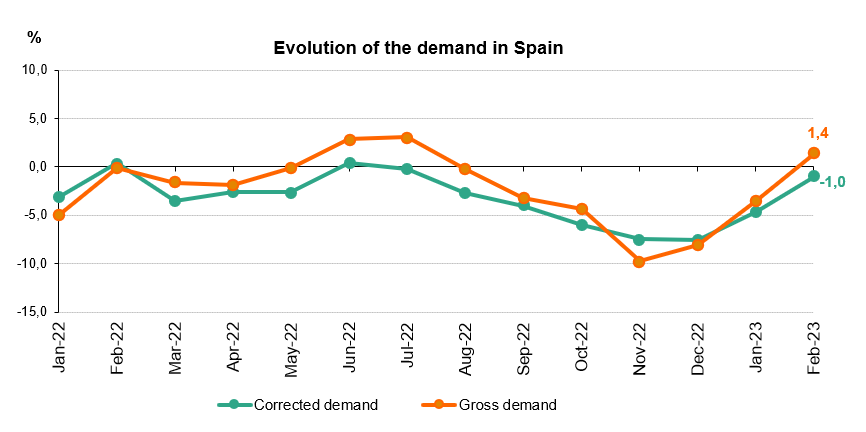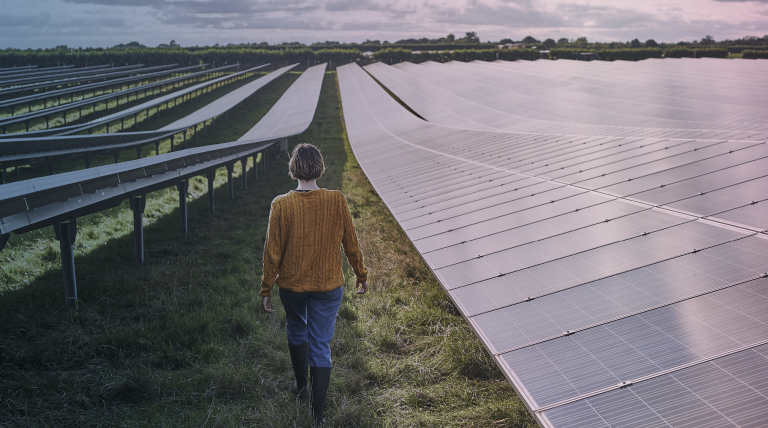For 40 years, we've been driving our country's economic and social progress. Four decades shaping Spain.
Demand for electricity in Spain fell by 1% in February
- Renewable energy production accounted for 45.5% of the mix, reaching 9,929 GWh, up 20.5% year-on-year
- Generation in Spain obtained using zero-carbon energy technologies accounted for 67.2% of the monthly total
- Wind power continues to lead the generation mix with a share of 21.4% of the total and solar photovoltaic, with a total of 2,095 GWh, recorded its highest production in any month of February
National electricity demand in February experienced a 1% decrease year-on-year after having factored in the influence of seasonal and working patterns. In gross terms, demand is estimated at 20,447 GWh, up 1.4% on February 2022.

In the first two months of 2023, Spain registered a demand of 42,374 GWh, down 1.2% compared to the same period last year. Again, after having factored in the influence of seasonal and working patterns, demand is down 2.9% compared to 2022.
Renewable energy generation during the month was 20.5% higher than in February 2022, reaching 9,929 GWh, accounting for 45.5% of the total generation mix nationwide, a share that on some days exceeded 60%.
On the other hand, electricity production obtained using zero-carbon energy technologies accounted for a 67.2% share in the overall mix.
According to data estimated at the time of this press release, wind was the leading source of energy source in February, with a production of 4,662 GWh and a 21.4% share of the total generation mix.
Solar photovoltaic, with 2,095 GWh recorded in February, increased its production by 23.7% year-on-year, accounting for a share of 9.6% and reaching its highest production in any month of February. The total solar photovoltaic energy produced in the 28 days of February is the highest in the last five months (since September 2022).
Hydro, whose share in February was 11.7% of the total, increased by 117.4% compared to the same month in 2022, standing at 2,555 GWh.

Demand for electricity in the peninsular system falls by 1.2%
Regarding the mainland system, and after having factored in the influence of seasonal and working patterns, demand for electrical energy was 1.2% lower than in February 2022. In gross terms, demand stood at 19,315 GWh, up 1.2% year-on-year.
In the first two months of the year, electricity demand on the Spanish mainland stood at 40,040 GWh, up 1.4% on that recorded in 2022. After having factored in the influence of seasonal and working patterns, demand fell by 3.2%.
According to provisional data available at the time of this press release, the renewable power generation fleet on the Spanish mainland as a whole accounted for nearly 47.3% of the total mix in February, registering a production of 9,831 GWh, up 21.3% year-on-year. Zero-carbon energy technologies accounted for 70.2% of the total mix.
The energy generation mix on the mainland in February was also led by wind power, which accounted for 22.2% of the total, with a total production of 4,618 GWh during the month.
Demand for electricity in the Balearic Islands and the Canary Islands
Electricity demand in the Balearic Islands in February, after having factored in the influence of seasonal and working patterns, was 4.5% higher than in the same month of 2022. Thus, gross demand is estimated at 436,962 MWh, up 10% year-on-year. In the first two months of 2023, gross demand on the Balearic Islands is estimated at 887,111 MWh, up 2.9% on the same period of 2022.
In terms of generation, combined cycle, with a share of 74.7% of the energy produced in the Balearic Islands, was the leading energy source on the islands in February. For its part, renewable energy obtained using zero-carbon energy technologies in the Balearic Islands accounted for 9.2% of the total.
In addition, during this month, the submarine link between the Spanish mainland and Majorca contributed to covering 20.6% of the electricity demand in the Balearic Islands.
Electricity demand in the Canary Islands, after having factored in the influence of seasonal and working patterns, grew by 2.1%, compared to the same month in 2022. In gross terms, demand was 663,265 MWh, up 2.1%. In the first two months of 2023, gross demand on the Canary Islands is estimated at 1,381,836 MWh, up 1.4% on the same period of 2022.
With regard to electricity generation in the Canary Islands, combined cycle, with 44.7% of the total generation, was also the leading technology in February. Renewables and generation obtained using zero-carbon energy technologies reached a 10% share of production, with wind power accounting for 6.6%.
Consult our Daily Balance Report for more information on the National, Peninsular, Balearic Islands and Canary Islands electricity systems as at the close of February.












